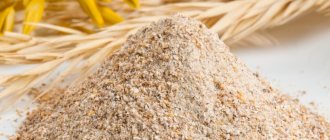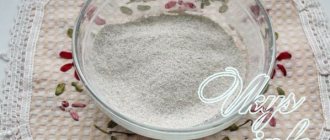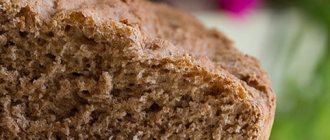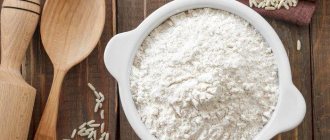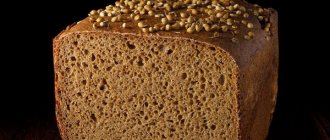Currently, the number of adherents of a healthy diet is growing every day, and therefore discussions about the benefits and harms of foods sometimes reach the point of absurdity. The most important product of the food chain – bread – was not left without attention. A huge number of “horror stories” have appeared on the Internet about the irreparable harm that ordinary yeast bread causes to our health and the indescribable benefits of so-called “yeast-free” bread baked with sourdough.
Let's first figure out what is true, and what is false and fiction in this statement, and then consider several recipes for baking homemade yeast-free bread.
So what is healthier – regular or yeast-free bread?
Here we must immediately make a reservation: the very concept of “yeast-free” bread is absurd. Such a product cannot exist, since the starter, which is prepared for 5-7 days, is, in fact, nothing more than an ordinary yeast culture. The fact is that yeast fungi in nature are found naturally in more than 1.5 thousand different products: on the surface of fruits (especially grapes), hop cones, in vegetables, cereals, in dairy and fermented milk products, and even in the surrounding air. In order for them to begin to ferment and multiply, special conditions are needed - moisture, warmth and sugar (fungi are real “lovers” of sweets).
By growing sourdough at home, bakers simply create conditions for the growth and reproduction of yeast fungi, which then become the basis of the dough for bread dough. And only thanks to them, homemade sponge bread turns out so fluffy and tasty. The only justification for sourdough lovers is the fear that industrial yeast is allowed by GOST to contain various chemical additives that ensure the shelf life of the product. But to believe that GOST allows the content of sulfuric and hydrochloric acid in compressed yeast is, at a minimum, not serious: yeast is a living culture that cannot survive in hydrochloric acid. Sometimes you can believe various rumors, but not to that extent!
Let us also dispel the last myth about the benefits and harms of yeast-free bread: yeast supposedly negatively affects the intestinal microflora, causing fermentation and bloating in the intestines. Yeast fungi, as a living culture, begin to actively reproduce at a temperature of 30-32 ° C, but at t + 60 ° C they already coagulate, that is, they die, turning into ordinary protein. And, since the baking temperature of any bread - both yeast and non-yeast - is at least +200 ° C, it is clear that there can be no question of any yeast in the finished bread.
The benefits and harms of bread with activated carbon
The passion for healthy products has led to the fact that in many countries around the world they began to bake baked goods with the addition of activated carbon. Today this additive has become quite common; charcoal has a neutral taste and practically does not change the technology of baking bread. For 1 kg of regular flour, add 15 g of coal, which makes the crumb black.
This bread is good for human health because:
- protects the gastrointestinal tract from the processes of decay and fermentation;
- reduces gas formation;
- easily absorbed by the body;
- helps recovery during chemotherapy;
- reduces general intoxication in case of burn injuries, food poisoning and various infections;
- saturates the body with vitamins, enzymes, and minerals.
Read: Benefits of honey and lemon for men
Coal bread is useful to include in the diet of people with metabolic disorders, viral and toxic liver damage, inflammatory processes in the kidneys and urinary system.
Coal bread causes harm during exacerbation of stomach ulcers, duodenal ulcers, and gastritis. It should be excluded from the diet of children under 3 years of age. In any case, it is useful to observe moderate consumption of coal bread and eat it in reasonable quantities no more than 2 - 3 times a week.
What determines the quality of bread?
In fact, the benefits and harms of yeast-free bread (as well as regular bread) lie in the quality of the flour used for baking. The whiter and softer the refined flour is to the touch, the less healthy carbohydrates it contains - fiber and cellulose, and the more simple, unhealthy, quickly digestible carbohydrates and starch. Accordingly, white bread has more calories and makes you feel better faster.
Whole grain flour contains healthy carbohydrates. The most ideal option is to grind whole grains in a home mill. This is the only way to be sure that there will be no harmful impurities in the bread - this is precisely the benefit of homemade yeast-free bread.
Manufacturers of bakery products use various additives, leavening agents, which increase the shelf life of the product and “improve” taste, harming the health of consumers. And yeast is not the most harmful component of ordinary store-bought bread. Therefore, to be sure of the high quality and benefits of this important food product, you need to stock up on good whole grain flour (wheat, rye or a mixture of them) and use one of the recipes below.
The benefits of rye (black) bread
There are several advantages of brown bread over white bread, thanks to which rye bread has a much better reputation among nutritionists, doctors and people leading a healthy lifestyle:
- Rye bread has a large amount of hard fibers that are not digested . These fibers are also known as fiber, which improves food absorption and stabilizes the digestive tract. In addition, rye bread helps remove harmful toxic substances and waste from the body, so it is recommended for consumption by people with intestinal diseases
- Less calorie . The blacker the loaf of bread, the more rye flour it contains, and, accordingly, the fewer calories. Thus, 100 grams of rye bread contains 174 kilocalories, in contrast to white bread, 100 grams of which contains 250 kilocalories. Therefore, everyone who wants to lose weight is recommended to eat not white bread, but black bread. Of course, this is not a low-calorie product, but it is still considered dietary because it is characterized by high satiety, which is why a person feels full.
- It contains more essential amino acids and vitamins . Rye grain is practically no different from the composition and beneficial properties of wheat flour, from which its “white counterpart” is made. However, rye is much more resistant to processing processes than wheat grains, and therefore retains much more useful components.
- Effective for anemia and useful for pregnant women . Rye bread is rich in beneficial microelements such as magnesium and iron, which stimulate the formation of blood cells and contribute to the proper formation of the fetus. Black bread also increases hemoglobin to the required level.
- It has a good preventative effect against serious diseases . Regular consumption of rye bread reduces the risk of the formation of malignant tumors, which lead to cancer. This product also prevents the onset of diabetes. Thus, according to research, scientists have found that women who eat black bread instead of white bread are three times less susceptible to diabetes.
Universal starter
So, in order for the dough to be fluffy and rise well, the bread dough is prepared with sourdough. There are many recipes for its preparation, but the principle is practically the same. Let's consider a universal recipe that is suitable for any home baking: bread, buns, Easter cakes, pies in the oven and pies fried in a frying pan.
The main thing is to create ideal conditions for fermentation and wait enough time for the starter to mature. If you plan to bake bread often (even every day), then it is better to immediately take larger dishes - for example, a 2-liter jar.
Ingredients:
whole grain flour (preferably rye) – 100 g;
warm water – 100 g;
sugar or honey - 1 tablespoon.
Preparing sourdough
1. Mix warm water with sugar or honey.
2. Pour flour into the jar, and then gradually add the liquid mixture, stirring thoroughly so that no lumps remain. You may need a little less liquid (depending on the quality and properties of the flour). In this case, you can use not the entire mixture or add a little more flour. The consistency should be similar to pancake batter.
3. Cover the jar with a cotton napkin or gauze in 4 layers to ensure air access to the starter, and place in a warm place.
4. After a day, add another 100 g of rye flour and 100 ml of warm water to the starter, mix everything thoroughly, cover, and place in a warm place.
5. On the third day, the fermentation process should already be clearly visible - the leaven is bubbling, releasing carbon dioxide, and a pleasant, slightly sour, bready smell emanates from it. It again needs to be fed with a standard amount of flour and warm water, and you can already add white whole grain wheat flour, especially if you intend to bake wheat bread. You can add a spoonful of sugar or honey to feed the fungal culture so that the fermentation process proceeds more vigorously.
6. On the fourth day, the starter is considered ready and you can already put the dough on it. To do this, use part of the “homemade yeast”, and the rest is again fed with flour, water, a small amount of sugar and left for 2-3 hours in a warm place. Then the starter can be put in the refrigerator for permanent storage.
Before each baking, the required part of the starter must be removed from the refrigerator in advance so that it has time to warm up to room temperature, and then be used for dough. Add flour, water, a little sugar to the rest, let it sit for an hour or two, and put it in the refrigerator.
A classic option for making yeast-free bread at home. Step by step recipe.
The starter should make up at least a quarter of the total amount of dough. Therefore, to bake one loaf of bread, you need to immediately take the necessary part of the starter and prepare the dough. If you plan to bake a large amount of bread (3-4 loaves), you can first prepare the dough from the sourdough to save the product. This usually takes 3.5-4 hours, so it’s best to put the dough in the evening and do the kneading in the morning.
Number of servings : 3-4 loaves of bread weighing 800-1000g.
Cooking time : about 10 hours.
Composition and calorie content per 100 g of product:
• proteins – 9g;
• fats – 3.3g;
• carbohydrates – 48 g;
• calorie content – 259 kcal.
Step 1 – prepare the dough. 250-300 g of starter is poured into a container, add 2 cups of rye flour or a mixture of rye and first-grade flour, 250 ml of warm water (t 32-35oC), 1 tablespoon of sugar, 1 teaspoon of salt. Mix everything well, cover the dish tightly with a lid and put it in a warm place for 3-4 hours. During this time, the volume of the dough should increase 2-2.5 times.
Step 2 – kneading the dough. Place the dough in a dough container, add 1.5 kg of flour or a mixture of different types as desired, mix a little and gradually add warm salted water (approximately 700 ml + 1 tablespoon of salt). The dough should be a little denser in consistency than for pancakes, kneaded evenly, without lumps, viscous and elastic.
IMPORTANT! Dough that is too dense will take longer to rise, and the bread will turn out less porous, the crumb will be dense and will go stale faster. Light, semi-liquid dough will produce airy, porous bread.
Step 3. The finished dough is placed in molds, previously generously greased with vegetable oil. The surface of the dough can be smoothed with a spoon moistened with water. The molds need to be covered (with a lid, cling film, plastic bag) and placed in a warm place for 3-4 hours so that the dough rises well and doubles in volume.
Step 4 – baking itself. The oven must be preheated at a temperature of 150-180°C. The baking time of the bread depends on the size of the mold: if the mold is tall and narrow, it will take about 2-2.5 hours to bake at a temperature of 150°C. Check readiness with a wooden skewer. If the shape is wide and flat, the baking time will be reduced to 1.5 hours.
The finished bread is removed from the mold and covered with a towel until it cools completely.
Composition and calorie content of rye bread
The composition of standard rye includes:
- Rye flour;
- water;
- leaven;
- salt.
Additional components of the product may include:
- nuts;
- plants' seeds;
- dyes.
The product contains substances necessary for the body (per 100 g):
- 6.6 g protein;
- 1.2 g fat;
- 34.2 g carbohydrates;
- 0.7 mg vitamin PP;
- 2.2 mg tocopherol;
- 1 mcg retinol;
- 0.18 kg thiamine;
- 0.08 mg riboflavin;
- 60 mg choline;
- 0.6 mg pantothenic acid;
- 0.17 mg pyridoxine;
- 30 mcg folic acid;
- 60 mg choline;
- 3.9 mg iron;
- 5.6 mcg iodine;
- 1.21 mg zinc;
- 1.6 mg manganese;
- 220 mg copper;
- 2.7 mcg chromium;
- 5 mcg selenium;
- 35 mcg fluoride;
- 23 µg boron;
- 8 mcg molybdenum;
- 40 mcg vanadium;
- 52 mg sulfur;
- 158 mg phosphorus;
- 35 mg calcium;
- 245 mg potassium;
- 47 mg magnesium;
- 610 mg sodium;
- 8.3 g dietary fiber;
- 0.2 g fatty acids (saturated).
The calorie content of bread made from rye flour is 174 kcal per 100 g. Often, as a result of grinding and cleaning the flour, beneficial substances are removed; such a product is not beneficial.
Quick recipe for delicious bread
The cooking time can be significantly reduced, and this will not affect the quality of the finished fragrant bread. Use the same proportions for preparing the dough, only we omit the process of preparing the dough.
300 g of starter is diluted with warm water, sugar, salt, flour are added and the dough is kneaded to the desired consistency. The molds are generously greased with oil, the dough is laid out and sent to a warm place to rise. Heat is a necessary condition for obtaining a good, fluffy dough. Although homemade bread is usually called “yeast-free”, sourdough, being a natural yeast culture, requires warmth, moisture and sugar for growth and reproduction. Without them, the dough will turn out too bland, non-porous and tasteless.
Bake the bread as directed in the previous recipe.

